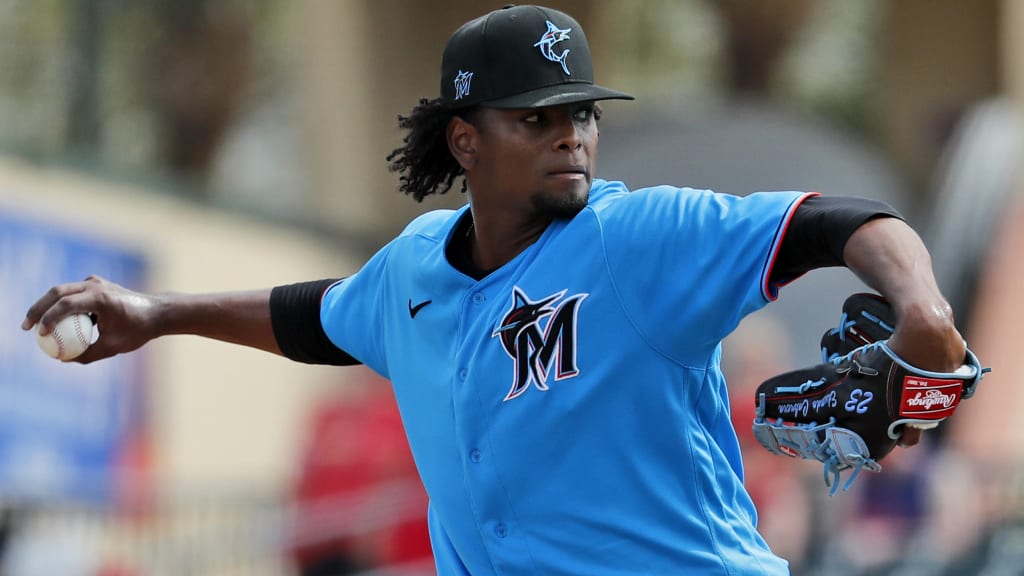Notes: Prospects in taxi squad; elite speed

As the Marlins take on the Braves this week at Truist Park, sitting socially distanced in the stands are nearly a dozen Miami taxi squad players, including many of the organization’s top prospects.
This group provides roster reinforcements to the Marlins, who are moving closer to clinching their first playoff appearance since 2003. As a contender, beginning Wednesday, the club will be entering a bubble environment.
“We go into the bubble tomorrow,” Mattingly said Tuesday on his Zoom call. “Whoever is with you has to be with you. If we’re fortunate enough to go to the postseason, that’s our group. There can’t be more changes after that. Those guys are quarantined at the hotel. They’re with us. They work out earlier in the day.”
Essentially, all playoff teams will have 40 players at their disposal. There will be 28 on the active roster with up to 12 more on the taxi squad.
Many of the taxi squad players are the Marlins' top prospects who aren’t currently on the active roster. They had previously been working out at the alternate training site in Jupiter, Fla.
Headlining the list is hard-throwing right-hander Edward Cabrera, ranked by MLB Pipeline as Miami’s No. 6 prospect and as the No. 84 prospect in baseball.
Along with Cabrera, there are four other pitchers: right-hander Jordan Holloway (the Marlins' No. 26 prospect) and lefties Dan Castano, Braxton Garrett (No. 7) and Alex Vesia.
Rounding out the group are six position players: infielder José Devers (No. 13); first baseman Lewin Díaz (No. 8); outfielders Jesús Sánchez (No. 5) and Magneuris Sierra; and catchers Ryan Lavarnway and Brian Navaretto.
A possible 12th player could join the taxi squad. On Tuesday, the Marlins announced infielder Sean Rodríguez cleared waivers, and he was outrighted to the alternate training site.
Only a few players have a chance to be on the playoff roster. But just being around the team and experiencing a playoff atmosphere is something Marlins chief executive officer Derek Jeter wants for the top prospects.
Cabrera likely would have been called up to the big leagues already if he hadn’t experienced some arm discomfort during Summer Camp. While he projects as a starter, he is expected to be a bullpen option if he is activated.
This browser does not support the video element.
“He’s healthy,” Mattingly said. “They’ve been building him up. It has been a slower build. They have been careful with him.”
The taxi squad players have been working out in the mornings at Truist Park, and they exit the clubhouse before the active roster arrives.
“We’re not having too many guys running around the clubhouse at the same time and things like that,” Mattingly said.
The Marlins will conclude their four-game series in Atlanta on Thursday and will finish the regular season at the Yankees this weekend. At any point in the final week, Cabrera would be a big addition to the bullpen.
An international free-agent signing in 2015 from the Dominican Republic, Cabrera took a major step forward in his development in '19. At Double-A Jacksonville, he sported a 2.23 ERA and recorded 116 strikeouts in 96 2/3 innings, and opponents hit .190 off him.
Cabrera’s four-seam fastball is in the 93-97 mph range and occasionally touches 100 mph. The 22-year-old has a three-pitch mix, with a plus slider and changeup, which is an out pitch for him.
“Obviously, his stuff is off the charts,” Mattingly said. “He’s a guy who would be available to us, as we start getting to the point of playoff rosters and things like that.”
Staying aggressive
Since Spring Training, the Marlins made it clear they intended to be aggressive on the bases. They showed that in Monday’s 5-4 loss to the Braves, when Monte Harrison attempted to go from first to third on a grounder by Matt Joyce in the ninth inning. Joyce’s chopper was fielded by pitcher Mark Melancon, who went to first for the out as Harrison made a dash to third.
But Freddie Freeman made a throw across the diamond to shortstop Dansby Swanson, who made a diving tag on Harrison. It became a much-discussed baseball play.
“We go back to Spring Training,” Harrison said. “We started this in Spring Training. We said that we are going to be an aggressive team. We're going to run the bases like [heck] and put pressure on people.”
This browser does not support the video element.
The Marlins have their share of speed. According to Statcast’s sprint speed metric, Jon Berti (29.2 feet per second), Harrison (28.8), Sierra (28.8), Starling Marte (28.5) and Lewis Brinson (28.5) are Miami's fastest players.
The MLB average is 27 feet per second. On that particular play, Harrison was tracked by Statcast at 31.2 feet per second; anything over 30 feet is considered elite.
